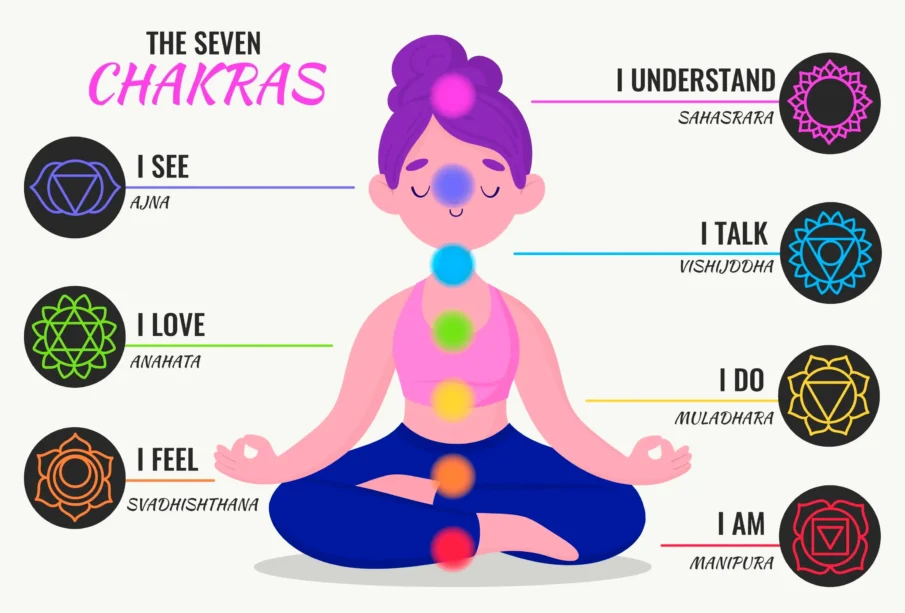The Complete Guide to the 7 Chakras: Symbols, Effects & How to Balance

Chakras, the energy centers in our bodies, play a vital role in our physical, emotional, and spiritual well-being. Understanding these energy centers, their symbols, effects, and methods to balance them is essential for achieving harmony and balance in life. Here’s a comprehensive guide to the seven chakras and how courses on meditation can help in balancing them effectively.
What is Chakras?
Chakras are energy centers within the subtle body, as described in various ancient Indian spiritual traditions, including Hinduism, Buddhism, and Tantra. The term “chakra” is derived from Sanskrit, meaning “wheel” or “disk,” which reflects the circular, spinning nature of these energy centers. According to traditional belief systems, the human body contains seven main chakras, which are aligned along the spine from the base to the crown of the head.
Each chakra is associated with specific qualities, elements, colors, sounds, and functions, and they are believed to govern various aspects of our physical, emotional, and spiritual well-being. When these chakras are open, balanced, and spinning harmoniously, they facilitate the free flow of life force energy (known as “prana” or “chi”) throughout the body, promoting health, vitality, and a sense of well-being.
7 Type of Chakras
1. Root Chakra (Muladhara):
Located at the base of the spine, the root chakra symbolizes stability, security, and our connection to the earth. When balanced, it instills a sense of groundedness and safety. Imbalances may manifest as anxiety, fear, or insecurity. To balance the root chakra, meditation techniques focusing on grounding, such as visualization of roots extending into the earth, can be beneficial.
2. Sacral Chakra (Swadhisthana):
Situated in the lower abdomen, the sacral chakra represents creativity, passion, and emotional well-being. A balanced sacral chakra fosters healthy relationships and emotional expression. Meditation practices that stimulate creativity and sensuality, such as dance or visualization, can help balance this chakra.
3. Solar Plexus Chakra (Manipura):
Located in the upper abdomen, the solar plexus chakra governs our self-esteem, confidence, and personal power. When balanced, it empowers us to pursue our goals with clarity and determination. Meditation techniques focusing on self-reflection, affirmations, and breathwork can help balance the solar plexus chakra.
4. Heart Chakra (Anahata):
Situated in the center of the chest, the heart chakra represents love, compassion, and connection. A balanced heart chakra allows us to give and receive love openly and unconditionally. Heart-centered meditation practices, such as loving-kindness meditation or heart-opening yoga poses, can nurture and balance this chakra.
5. Throat Chakra (Vishuddha):
Located in the throat region, the throat chakra governs communication, self-expression, and authenticity. A balanced throat chakra enables clear and truthful communication. Meditation techniques that focus on vocalization, chanting, or mindful speaking can help balance this chakra.
6. Third Eye Chakra (Ajna):
Positioned between the eyebrows, the third eye chakra represents intuition, insight, and spiritual awareness. A balanced third eye chakra enhances intuition and inner wisdom. Meditation practices that promote mindfulness, visualization, and inner exploration can help activate and balance this chakra.
7. Crown Chakra (Sahasrara):
Located at the top of the head, the crown chakra symbolizes spiritual connection, enlightenment, and divine consciousness. A balanced crown chakra brings a sense of unity and higher consciousness. Meditation techniques that facilitate spiritual connection, such as prayer, contemplation, or silent meditation, can help balance this chakra.
Is there a shape to a chakra?
The shape of the chakras is the subject of numerous myths. Some compare them to spinning discs, while others see flowers suspended from the spine. They even seem to resemble an ice cream cone to some individuals! The reason for the existence of all these many theories is that neither the eyes nor any technology can perceive the chakras. Therefore, we have a tendency to accept whatever is widely shared.
According to the old texts, a chakra has a ball or sphere-like form. Furthermore, it is even thought that Earth is a minor chakra in the Milky Way galaxy and a significant chakra in the solar system. To disperse some energy, it rotates, but learning more about this.
What is the size of a Chakra?
Some people say that chakras are one foot in radius, while others say that they change their size according to the energy flow. Scriptures, on the other hand, tell us that the chakras are very small, as they are located in the astral spinal cord, which is further located inside the physical spinal cord.
Incorporating Courses on Meditation:
Courses on meditation provide valuable tools and techniques for balancing the chakras. Guided meditation sessions specifically designed to target each chakra can help individuals identify and release energy blockages, leading to a more harmonious flow of energy throughout the body. Additionally, mindfulness practices taught in meditation courses can enhance self-awareness and facilitate the alignment of the chakras. By incorporating meditation into your daily routine, you can cultivate a deeper understanding of the chakras and promote overall well-being on physical, emotional, and spiritual levels.
Also Read: 20 Facts About Meditation: Scientific, Surprising, and Unknown Discoveries
Thanks For Reading!
Leave a reply
You must be logged in to post a comment.






